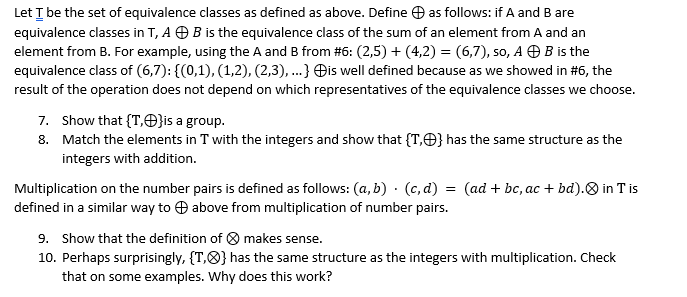Multiplication on the number pairs is defined as follows: (a, b) · (c, d) defined in a similar way to O above from multiplication of number pairs. (ad + bc, ac + bd).O in Tis 9. Show that the definition of 8 makes sense.
Multiplication on the number pairs is defined as follows: (a, b) · (c, d) defined in a similar way to O above from multiplication of number pairs. (ad + bc, ac + bd).O in Tis 9. Show that the definition of 8 makes sense.
Elements Of Modern Algebra
8th Edition
ISBN:9781285463230
Author:Gilbert, Linda, Jimmie
Publisher:Gilbert, Linda, Jimmie
Chapter1: Fundamentals
Section1.7: Relations
Problem 3E: a. Let R be the equivalence relation defined on Z in Example 2, and write out the elements of the...
Related questions
Topic Video
Question
please answer question number 9

Transcribed Image Text:Let I be the set of equivalence classes as defined as above. Define O as follows: if A and B are
equivalence classes in T, A O B is the equivalence class of the sum of an element from A and an
element from B. For example, using the A and B from #6: (2,5) + (4,2) = (6,7), so, A OB is the
equivalence class of (6,7): {(0,1), (1,2), (2,3), ...} Đis well defined because as we showed in #6, the
result of the operation does not depend on which representatives of the equivalence classes we choose.
7. Show that {T,O}is a group.
8. Match the elements in T with the integers and show that {T,O} has the same structure as the
integers with addition.
Multiplication on the number pairs is defined as follows: (a, b) · (c, d) = (ad + bc, ac + bd).O in T is
defined in a similar way to O above from multiplication of number pairs.
9. Show that the definition of 8 makes sense.
10. Perhaps surprisingly, {T,8} has the same structure as the integers with multiplication. Check
that on some examples. Why does this work?
Expert Solution
This question has been solved!
Explore an expertly crafted, step-by-step solution for a thorough understanding of key concepts.
This is a popular solution!
Trending now
This is a popular solution!
Step by step
Solved in 3 steps

Knowledge Booster
Learn more about
Need a deep-dive on the concept behind this application? Look no further. Learn more about this topic, advanced-math and related others by exploring similar questions and additional content below.Recommended textbooks for you

Elements Of Modern Algebra
Algebra
ISBN:
9781285463230
Author:
Gilbert, Linda, Jimmie
Publisher:
Cengage Learning,

Elements Of Modern Algebra
Algebra
ISBN:
9781285463230
Author:
Gilbert, Linda, Jimmie
Publisher:
Cengage Learning,